- Moderator
- #1
The outcome of bad wiring on a GL1800.
This guy just got his '07 Honda Goldwing back from the mechanics. Turns out faulty trailer wiring was the culprit. Hopefully the bike owner had good insurance.
This guy just got his '07 Honda Goldwing back from the mechanics. Turns out faulty trailer wiring was the culprit. Hopefully the bike owner had good insurance.






